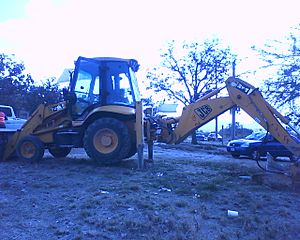Bosque el Nixticuil facts for kids
The Bosque el Nixticuil (Nixticuil Forest) is an old forest located near Zapopan, Mexico. It is an urban forest, meaning it is surrounded by the growing city of Guadalajara. This forest is mostly made up of oak trees, holm oak trees, and pine trees.
The Nixticuil Forest is a small part of a much larger forest that used to cover over 27,000 hectares. Its name comes from a local hill called El Nixticuil.
Contents
Forest Features
How Big is the Forest?
The Nixticuil Forest covers about 1,860 hectares. A big part of it, 1,591 hectares, is a protected area. This means it's a special place where nature is kept safe. This protected part helps keep the water clean for the Río Blanco area.
Animals and Plants
The forest is home to many different animals. You might find coyotes, foxes, skunks, rabbits, and opossums. There are also many kinds of small animals, birds, reptiles, amphibians, and insects.
Scientists have counted 107 different kinds of birds in the forest. Some of these birds are rare, and others are in danger of disappearing.
Besides oaks, pines, and holm oaks, the forest has many other plants. These include kidneywood, copal, mallow, mugwort, and foxtail grasses. You can also find willow trees, amate fig trees, and cat's claw and needle bush acacias. The forest is also one of only three places where a special white-flowering shrub called Styrax jaliscana grows.
Threats to the Forest
The Nixticuil Forest faces several dangers. Groups like the Comité Salvabosque de El Nixticuil work hard to protect it.
Protecting the Forest
In 2005, local people and activists asked the city of Zapopan to make 30 hectares of the forest a "Protected Area." This happened after a landslide in 2004 affected a nearby community. The city wanted to build new homes for these people in the forest.
People living near the forest and those affected by the landslide joined together. They protested to stop the construction and save the trees. On May 18, 2005, they managed to stop the work again. By then, over 300 oak trees had already been cut down.
Other groups also wanted to build in the forest. One group planned a building complex, and a university wanted to build a "University Science and Technology Research Park."
Finally, on February 19, 2008, the government officially protected 1,591 hectares of the forest. This stopped many of the building plans. However, some groups still try to build there, and activists continue to fight for the forest.
Forest Fires
Fires are a big danger to the Nixticuil Forest. Environmental groups believe some fires are started on purpose. This might be to clear land for building.
These fires harm the animals and plants. They also make it easier for the city to grow into the forest.
Illegal Logging
Logging means cutting down trees. When it's done illegally, it causes a lot of damage. Illegal logging is a main reason why animals and plants are disappearing from the forest. It has become a bigger problem as the city grows closer to the forest.
See also
 In Spanish: Bosque El Nixticuil para niños
In Spanish: Bosque El Nixticuil para niños



